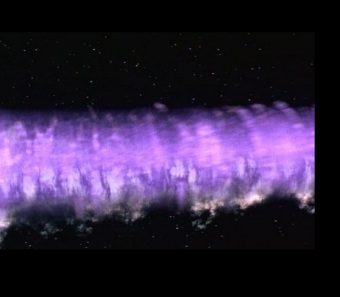
In Star Trek, a subspace shock wave is a violent
compressional wave caused by a massive energy discharge which travels
through the medium of subspace. These phenomena are typically created
by the destruction of large planetary or stellar bodies.
In 2293, a subspace shock wave was created from the
explosion and partial destruction of the Klingon moon, Praxis. The
effects of the shock wave caused severe damage to Qo'noS, as well as
minor damage to the nearby USS Excelsior. (Star Trek VI: The
Undiscovered Country; VOY: "Flashback") The unusual supernovae caused
by the Q Civil War of 2373 generated subspace shock waves. The shock
waves collapsed the USS Voyager's warp field, preventing its escape and
causing severe damage. (VOY: "The Q and the Grey")
Similar shickwaves also occur in the real universe,
frequently as a result of supernovae. They can even been observed. In
October 2002, a supernova shockwave plowing through interstellar space
at 500,000 kilometers per hour was observed by the Hubble Space
Telscope. This shockwave is known as the Pencil Nebula, or NGC 2736,
and is part of the Vela supernova remnant, an expanding shell of a star
that exploded about 11,000 years ago. Initially the shockwave was
moving at millions of kilometers per hour, but the weight of all the
gas it has swept up has slowed it considerably. The above region spans
nearly a light year across, a small part of the 100+ light-year span of
the entire Vela supernova remnant.
The explosion of a supernova expels much or all of a
star's material at a velocity of up to a tenth the speed of light,
driving a shock wave into the surrounding interstellar medium. This
shock wave sweeps up an expanding shell of gas and dust called a
supernova remnant. The expanding shock waves from supernova explosions
can trigger the formation of new stars.
The three iconic pillars of cool interstellar hydrogen
gas and dust that form part of the famous Eagle Nebula (also called
M16), a star-forming region 6,000 light-years from Earth in the
constellation Serpens, may have also now disappeared as a result of a
shockwave. New data from NASA's Spitzer Space Telescope shows the
pillars being scorched by an exploding star - and a shockwave has
probably torn them apart. But because of the time taken for light to
reach Earth from such a distance, we will not see their final
destruction for 1,000 years.
The subspace shock wave was invented in Star Trek
because a real shock wave traveling at sublight speeds from Praxis
would have taken years to reach the Excelsior.
|
